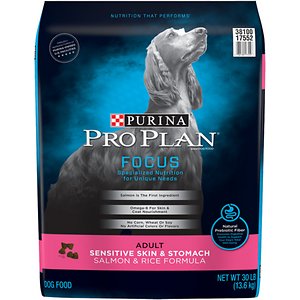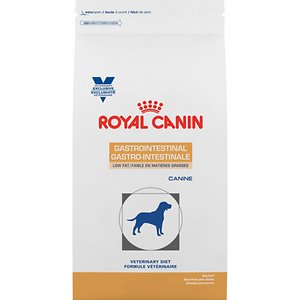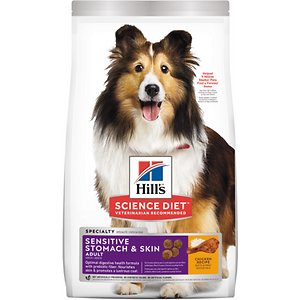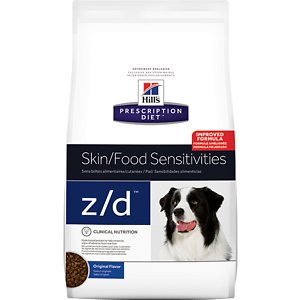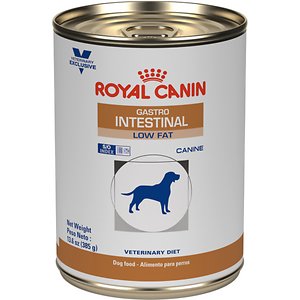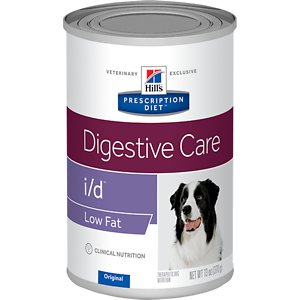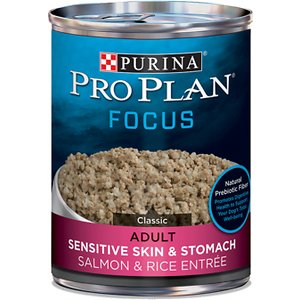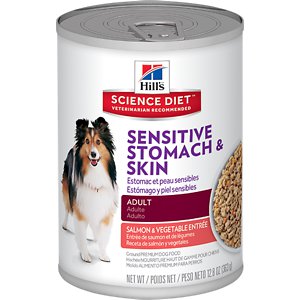A sensitive stomach leads to all kinds of unpleasant symptoms in dogs and puppies. Finding the cause is important, but you may need to switch to a different dog food to help alleviate your pet’s symptoms.
We’ve put together a comprehensive guide to dry and wet dog sensitive stomach dog foods, along with advice, facts, and things to know about the best dog foods for sensitive stomachs. There are plenty of solutions out there.
Jump to (dry):
Jump to (canned):
For the purposes of this article, the terms canned dog food and wet dog food are interchangeable.
All you need to do is to figure out which one would be most suitable for your dog. Once you find it, all those nasty symptoms will disappear.
Best Dry Sensitive Stomach Dog Food

The first type of food you could switch to is dry sensitive stomach food. This has the advantage of being available in larger sacks and bags. It also creates less waste as you don’t have lots of cans to get rid of.
You don’t need to worry about refrigerating it either, which is ideal if you need to take some on holiday with you or away on a day trip. Below are some of the best dry sensitive stomach food options around at present – one of which could be the ideal food to give to your dog.
Purina Pro Plan Focus Adult Sensitive Skin Dry
World renowned pet food manufacturers Purina have produced yet another amazing sensitive dog food formula. Their formula is specially designed to help dogs suffering from sensitive skin as well as stomach issues, and it does so brilliantly. Its effectiveness shines through, all while offering incredible value for money when compared to other brands in the same space. In all, it’s a wholly nutritious formula that provides a balanced meal for your dog that is easy on the tummy.
Salmon is a great source of protein and Omega 3 fatty acids, which to help improve your dog’s coat and joint health. The mix also includes oatmeal, which is easier to digest than many other carbohydrates found in dog food. It’s available in four bag sizes, with a convenient 5lb bag size available that makes it easy to try it out before committing to more.
Royal Canin Veterinary Diet Gastrointestinal Dry
This product from Royal Canin requires the approval of a vet, so you can buy it on prescription. It is very highly rated by customers and comes in three handy bag sizes, so you can purchase the one that makes most sense for your dog.
This dry food is low in fat and includes proteins that are easy for your dog to digest. It also contains prebiotics to help with digestion and maintaining healthy bacteria in their stomachs. The kibble is available in one easy size that is small enough for all dog breeds to manage.
Hill’s Science Diet Adult Sensitive Stomach Dry
This mix includes a prebiotic fiber to help aid your dog’s digestion. No artificial preservatives are contained in the kibble, and no artificial colors appear in it either.
Based on a chicken recipe, the formula has been designed to appeal to dogs with sensitive stomachs and skin, as the two often go together. Vitamins, Omega 6 fatty acids, and antioxidants round out the mix, providing your dog with all the nutrients and elements they need to enjoy improved digestion. It is also ideal for dogs of all breeds and sizes. Full feeding instructions are provided.
Hill’s Prescription Diet z/d Original Skin/Food Dry
Prescription diets are a good idea if your vet thinks your dog would benefit from something specific. This Hill’s Prescription Diet food requires a prescription and offers a dry food solution designed to resolve issues caused by allergies and intolerances.
It uses just one source of carbohydrate which comes from corn starch. It also has hydrolyzed protein, which is far easier for your dog to digest. They have also developed the kibble to include fatty acids and antioxidants, all of which can lead to improved digestive health.
Feeding Guide for Dry Sensitive Stomach Food
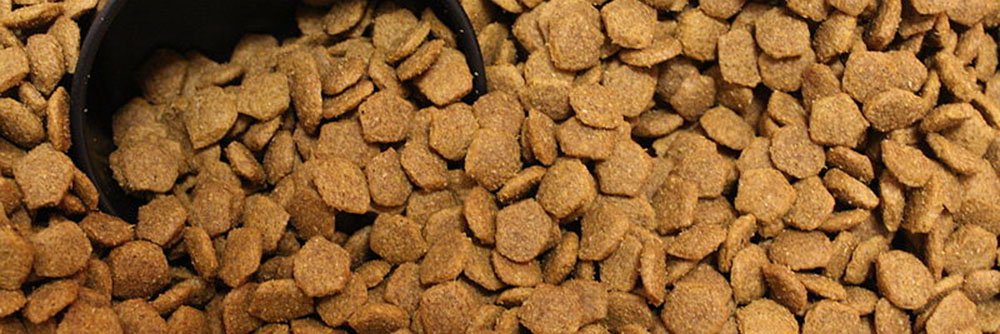
Many dog owners prefer dry dog food to canned dog food. It can be cheaper to buy, as it comes in larger bags for better value. These often have press closures to keep the food from going stale once the bag has been opened.
If you decide to decant the food into plastic storage containers, be sure to wash the containers prior to refilling them. Oils and dust can build up inside if you don’t. This can cause the food to spoil if the oils go rancid. At the very least, the food won’t taste the same and it could put your dog off eating it.
Look for a dry food with ingredients that don’t cause issues for your dog
This is the whole point, obviously. However, it is best to make sure you know (or at least have a very good idea) of the cause of your dog’s issues. For example, if you think mixed proteins are causing issues, look for a dry food that uses just one form of protein. Better still, make sure you know which protein your dog’s tummy is happy to digest.
Keep it simple
You are likely to find lots of ingredients in your chosen dry food. However, the best quality dog foods for pets with digestion issues normally have far fewer ingredients than you would find in regular kibble.
Watch out for vague words and phrases too, such as animal derivatives. This means products that are derived from animals… but as to which animals or which items, it’s anyone’s guess. When you are trying to find the ideal food for your dog that will get rid of their symptoms, vague terms such as these aren’t going to help. Instead, look for chicken, beef, fish… something that is precise and reveals exactly which source of protein (in this example) is present in the food.
Note the percentages of the main elements of food present
The good news for dog owners in the United Kingdom is that dog food must be labelled with the correct percentages of the main nutrients in the food. These are:
- Protein
- Fiber
- Fat
- Ash
This is useful to know. If you have worked out that your dog suffers issues when eating foods that are too fatty, you will know to choose a kibble with the lowest fat percentage you can find.
Bear in mind, though, that protein percentages apply to all forms of protein in the food.
If the kibble has a mix of two protein sources, you can’t know for sure whether they are presented in equal amounts or mixed percentages. Only the total is given.
Pay close attention to the feeding guide
Even if your dog is currently eating kibble and you’re switching to another dry dog food, don’t assume they should have equal proportions of each. There will be a feeding guide on the back of the pack that tells you how much each dog should have. This is usually given as a weight guide. For example, an upper and lower quantity of kibble in grams should be given to a dog of 7.5kg, and so on.
Adjust the kibble gradually, reducing the amount of the old food you are giving your dog and introducing some of the new food. Adjust the balance until only the new kibble is being fed to them. This alone will minimize any digestive upset that might be caused by switching to the new food. It will also help you get a more accurate picture of how your dog is reacting to the new kibble.
Best Canned Sensitive Stomach Dog Food

Canned dog food has a far higher moisture content than dry food. It will often contain gravy or jelly along with the main ingredients. Some dogs prefer wet food to dry, and if your pet falls into this category, you’ll likely want to switch them to an alternative wet food for sensitive stomachs.
The following options all contain essential ingredients in a balanced formula. Always check the recommended amount to feed your dog each day. Consider what might be causing your dog’s problems and choose the most likely solution. Here are our top picks for the best canned sensitive stomach dog food, each containing everything you need in a healthy diet.
Royal Canin Veterinary Diet Gastrointestinal
These 385g cans of gastrointestinal dog food provide a low-fat solution for your dog’s stomach woes. Available in a case of 24 cans, prescription approval from your vet is required prior to ordering. This proves the food is among the best available on the market today.
Fish oils and prebiotics are included in the food to optimize your dog’s digestive health. The proteins included in the mix are designed to facilitate easier digestion too. Fiber is also present to encourage healthier stools. Every element of your dog’s diet has been carefully considered when creating this wet dog food mix.
Hill’s Prescription Diet i/d Digestive Care
Another prescription alternative for those looking for tinned food, this Hill’s Prescription Diet offering is also low in fat. It comes in a case of 12 cans, offering you the convenience of ordering in bulk for a better price.
The formula has been designed to offer a low-fat dog food with finely balanced nutrients to encourage good digestion in your dog. The easily digestible mix includes Omega 3 fatty acids, prebiotic fibers, and antioxidants. These all have positive associations with healthy skin and coat, along with a better digestive system.
Purina Pro Plan Select Classic Sensitive
This Purina Pro Plan wet dog food mix provides a salmon and rice combo that is easy on the stomach and good for digestion. This formula is 100% complete, so you can give it to your dog and feel confident they are getting everything they need to maintain good health.
The salmon provides Omega 6 fatty acids and DHA, encouraging a healthy coat and skin and protecting their cognitive abilities too. Meanwhile, the rice is easy to digest and provides a source of carbohydrate. No artificial colors or flavors are added. The mix does not include preservative either, so proper storage after opening is essential.
Hill’s Science Diet Adult Sensitive Stomach
A tasty mix of salmon and vegetables guarantees your dog will love this canned dog food from Hill’s Science Diet. Available in a 12 pack of 363g cans, the contents come in a loaf that can be easily broken down ready for your dog to eat.
Nothing artificial has been added to this recipe. Grain-free salmon, vegetables, and even apples make their way into a recipe your dog will doubtless want every day. The fiber present in the vegetables ensures easier digestion, while the fatty acids from the salmon mean your dog will enjoy less sensitive skin and a healthier coat.
Feeding Guide for Canned Sensitive Stomach Food

It’s best to start by looking for canned dog food that provides a complete nutritional meal for your dog. If the food does not meet these requirements, your dog is more likely to miss out on essential vitamins and minerals.
This alone can lead to problems with their digestive system, along with the chance of other health issues such as poor skin.
Before you purchase any food, check the feeding guide given on the tin. How much will your dog need per day? This varies widely between breeds and sizes of dogs. A small dog may need less than a tin per day, whereas a larger dog may require two or more cans.
Do you know what is causing your dog’s digestive issues?
If you have managed to figure out what the problem is, make sure you read the ingredients on the label of the can. These should be clearly indicated online if you intend to purchase the food from a website.
It’s always best to rule out certain foods before you start buying new ones.
For example, you may have identified your dog’s main meal as the issue. But do you know whether that meal has too much fat present or too many sources of protein? By determining the answer, you can pick out a canned sensitive stomach food more easily, increasing the chances you’ll pick the right one first time.
How many ingredients are on the label?
It’s easy to be impressed by a tasty picture of chicken in gravy on the front of a tin of dog food. However, can you be sure the food only has chicken in it? Not unless you read the label.
The list of ingredients will tell you exactly what is in the tin. The ingredients with the biggest proportions in the final mix will be first on the list.
You should also look and see whether there are any triggering items in there. Once you know the likely reason for your dog’s dodgy stomach, you can read labels to ensure you do not buy anything featuring that foodstuff. Even if it appears only in minute amounts far down the list of ingredients, it could still be enough to upset their digestion.
Make the change gradually
Even if you have identified your dog’s existing food as the reason why they are suffering from digestive issues, it is best not to get rid of it and switch to the new food in one go.
Any change in food can cause digestive issues, even if the new food doesn’t give them any adverse reactions.
Reduce the existing food source by a quarter and replace it with some of the new food, considering the feeding directions for your dog’s breed, age, and size. After a couple of days, go for 50% of each food. Give it another two days and you can make it 75% of the new food topped up by 25% of the old. You can then switch completely to the new food.
This means your dog will adapt to the gradual change from easily. You should also be able to tell whether their symptoms are improving compared to how they were before.
What should you do with opened cans of dog food for sensitive stomachs?
If you do not need to feed your dog an entire can at a time, make sure you take out the remains of the food and keep it in a plastic container with a secure lid. It will need to be refrigerated once opened, to keep it fresh and free from bacteria formation.
Choosing the right dog food for sensitive stomachs

You’ve probably heard the saying, ‘You are what you eat.’ The same applies as much to dogs as it does to humans. Some dogs seem capable of eating anything and everything they’re given (although of course a dog-friendly diet is always of paramount importance). However, other dogs have sensitive stomachs, just as some humans do.
If your dog has problems digesting their food, your first port of call should always be your vet.
There are various health conditions that can potentially cause digestive problems, so it is important to rule these out. On some occasions, a vet may discover an issue that, with treatment, can be fully resolved.
However, if your pooch comes out with a clean bill of health and is still exhibiting all the signs of a sensitive stomach, it might be time to consider trying a different type of food.
Firstly, how do you know if your dog has a sensitive stomach?
There are three essential signs that may appear. Not all dogs have all three; some might only show one or two. You can probably guess what the signs are, since we suffer from the same ones if we have trouble with certain foods:
- Being sick
- Having ‘the runs’ – soft poos or diarrhea
- Excessive wind
Watch out too for a loss of appetite, excess salivation and swallowing (one usually leads to the other), and just being off-color. You’ll know if your dog is feeling poorly as they won’t be their usual bouncy self. Keep an eye out for other symptoms should this occur.
Of course, it’s common for all dogs to occasionally experience one or more of these symptoms. It rarely means you have anything to worry about. However, if a pattern develops and your vet can find nothing wrong, all the signs point to a sensitive stomach as the cause of their symptoms.
When are dogs most likely to develop a sensitive stomach?
Dogs will either be born with this condition or will develop it during their life. For instance, some breeds (German Shepherds are one example) are more prone to it than others. You may have a puppy that immediately exhibits signs of a sensitive tummy.
Conversely, your pooch may have grown up just fine and then shown signs of being upset by certain foods later. This can occur following an illness.
What causes a sensitive stomach in dogs?

There can be several reasons why a certain dog might experience a sensitive stomach when fed certain foods. There is also a scale of severity here, which means one dog might experience mild symptoms while another might experience severe symptoms.
This holds true even when the two dogs both get problems with the same foods.
However, there are certain areas that are most likely to cause digestion issues in dogs and puppies. Let’s look at those now. Understanding the different options will help you choose the best dog food for sensitive stomachs.
Protein
All dogs need protein to help them thrive. However, while your dog may love chowing down on beef, their stomachs may have different ideas! Changing from one source of protein to another will help identify whether they are sensitive to one or more of them, such as chicken or even fish. Consider trying foods based on single sources of protein rather than those with two or more in the same mix.
Fat
The higher in fat a dog’s diet is, the more trouble the animal is likely to have digesting it. Switching to dog food with a lower fat percentage can help rule out this as a possible cause – or identify it as the culprit. Look at your existing dog food and find one with a lower fat percentage to see what happens.
Fiber
Fiber helps things move along as they should, as is the case with humans. If your dog has digestion issues, it could mean they are not getting enough fibre. Some dog foods contain more than others, so do some comparisons to see where it falls on the scale from ‘lots’ to ‘hardly anything’.
Food quality
Not all dog food is created as equal. Some of the ‘cheap and cheerful’ stuff might be good for your budget, but it may not be doing your dog any good. It is always vital to feed your pup a good-quality dog food. A closed formula option means they will get the same thing each time too.
Food made to an open formula means the components could change. For a dog with a sensitive tummy, that can be a disaster.
It’s a good idea to discount any potential anxiety your pet might be suffering from too. You know how your stomach can churn and get upset if you are anxious or worried about something. Your pet can react in just the same way.
Separation anxiety can result in an upset stomach. Other external issues can also have an effect. For example, do they exhibit the symptoms after traveling in the car? Ruling out these elements is a good idea before progressing to food-related issues.
Don’t forget their treats

The obvious place to begin when your dog is suffering from a sensitive belly is their main source of food – their breakfast and dinner. This could certainly be the cause of their issues. However, you shouldn’t forget the other things they might get during the day.
Do they eat any dog treats? Note the ingredients in those. You may want to increase their main meals and withdraw the treats for a few days first. This could be an easy solution. If you withdraw the treats and they get better, you’ll know those are to blame. If there is no change, you know their main food source is to blame.
How to change from their existing food to a dog food for sensitive stomachs
Don’t make the switch in one fell swoop, otherwise you could end up with even more digestive issues to deal with. The best bet is to gradually reduce their current food while introducing the new food.
Conclusion
It’s not easy to watch your dog or puppy suffering the symptoms of a sensitive belly. However, with some experimentation and perseverance, you can find out what is causing the problem and switch them to a better source of food.
With lots of options out there today – both dry and wet food as we’ve seen – you can soon get your dog on the road to better health and happiness. Once you’ve found the solution, stick to it – your dog will love you all the more for your hard work!
Did you find this article helpful?

